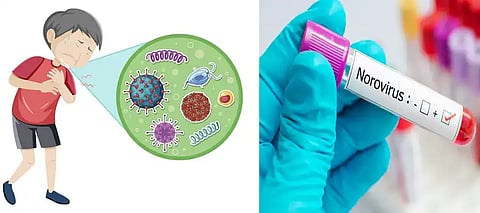

The United States is witnessing a concerning rise in norovirus cases, with 91 infections reported in the first week of December, up from 69 in the previous week, according to data from the US Centers for Disease Control and Prevention (CDS). Known for its highly contagious nature, norovirus is often referred to as the “Winter Vomiting Hub,” and its impact is being felt not just in the US but also in countries like India, where smaller outbreaks, particularly in Kerala, have raised alarms.
Norovirus is a highly contagious virus that causes gastroenteritis, an inflammation of the stomach and intestine. It spreads primarily through contaminated food, water, and surfaces, as well as direct contact with infected individuals. This virus is most commonly transmitted via the oral-fecal route and can survive on surfaces for days, making it a persistent threat in closed and crowded spaces like cruise ships, dormitories, and nursing homes.
The World Health Organization (WHO) estimated that norovirus is responsible for around 685 million infections annually worldwide, with 200 million cases occurring in children under five. It is also the leading cause of foodborne illness in the United States, contributing to 58% of all reported cases.
Symptoms of norovirus typically appear 1-2 days after exposure and include:
While the illness is usually short-lived, dehydration caused by vomiting and diarrhea can be severe, especially in young children, the elderly, and those with weakened immune systems.
It can survive temperatures up to 60°C and is resistant to many disinfectants, including hand sanitizers. Preventing infection requires too many disinfectants, including hand temperatures up to 60°C, and is resistant to many disinfectants, including hand sanitizers. Preventing infection requires rigorous hygiene practices:
There is currently no specific treatment or vaccine for norovirus. Most infections resolve on their own within two to three days. The primary treatment is focused on staying hydrated and replenishing lost fluids and electrolytes. In severe cases, hospitalization and intravenous fluids may be required.
The global impacts and the need for vigilance with its rapid spread and resilience, norovirus remains a persistent public health challenge worldwide. In India, while outbreaks remain sporadic, states like Kerela have reported clusters of infections, highlighting the virus’s ability to cause localized health crises.
Health authorities urge the public to prioritize hygiene, follow food safety measures, and remain vigilant, especially during the winter months when norovirus activity peaks. Early detection, proper hygiene, and prompt medical attention are key to controlling outbreaks and minimizing their impacts.
Stay informed stay cautious, and prioritize hygiene to protect yourself and those around you from norovirus.